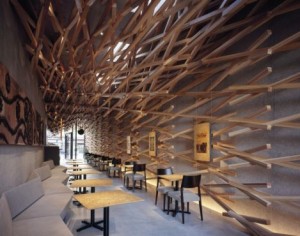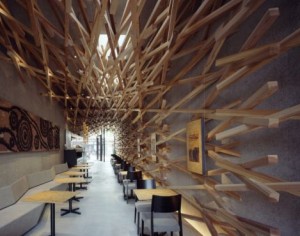The walk up to Dazaifu Tenmangu, a popular Shinto shrine in Fukuoka, Japan, is a treat for the senses – a pathway lined with busy vendors selling everything from lucky charms to sweet plum-filled mochi rice cakes.
Among these bustling shops is a Starbucks store unlike any other, designed by acclaimed Japanese architect Kengo Kuma.
Featuring an intricate matrix of more than 2,000 wooden sticks, the store reflects the neighborhood’s traditional artistic roots, while capturing the modern energy of this world-famous tourist destination.
Starbucks global design team recently had the opportunity to host Kuma and his colleague Junji Ito at the company’s home office in Seattle. It was a reunion of sorts since Kuma’s firm worked with Starbucks back in 2011 to design the iconic store in Japan. Gathered around cups of freshly brewed Casi Cielo, the Starbucks design team is full of questions for Kuma and Ito.
“This store brings such a unique perspective,” said Bill Sleeth, Starbucks vice president of design for the America’s. “We do so many projects each year, but with this one store, we found a whole new idea for what a store could be. What inspired you to create this design?”
“Curiosity,” Kuma replied. “A curiosity about the culture, the materials, and the people. That becomes the basis of any good design.” Kuma was inspired by the neighborhood. “That’s where it all started,” he said. “Dazaifu Tenmangu is a very special location, a historic shrine, for locals and visitors. I wanted to show the essence of the place to honor its strong culture of craftsmanship. If we could combine Starbucks spirit with the spirit of the artisan, we knew we could achieve something special.” “The result feels like it is truly handmade,” Sleeth said. He’s referring to the thoughtful detail Kuma’s firm put into every corner of the store, starting with his use of an intricate diagonally woven cedar wood lattice – the most visually striking aspect of the space.
Kuma’s team had previously experimented with the style for projects at Chidori and GC Prostho Museum Research Center, adjusting the fulcrum on the weave to better suit the café’s space. With the complex weaving, Kuma ultimately wanted to “create a feeling of fluidity, a thoughtful cave-like space.” Each stick, ranging in length from four feet to 13 feet, together adds up to nearly three miles of wood.
“Despite the handmade feel of the space, it also feels high-tech and advanced,” said Ito. “It’s a good mix of traditional and contemporary.”
Working with artists like Kuma is a reflection of Starbucks growing focus on bringing locally-relevant design to communities around the world by creating a space that truly honors the culture of each neighborhood.
In Amsterdam, customers will find Starbucks in a historic bank vault. A New Orleans Starbucks is inspired by the city’s strong mercantile and jazz roots. In Bangkok, a Starbucks store shares profits with coffee farmers in northern Thailand. While the Starbucks has 18 in-house design studios around the world, collaborating with renowned architects like Kuma offers an opportunity to explore new ideas in design and reach new neighborhoods in an authentic way. “Kuma’s design sensibility matched Starbucks point of view,” said Sleeth. “It was this incredible opportunity to try something new and it worked. It’s the type of design that provokes conversation and becomes part of the customer’s memory of their visit to Dazaifu.”
The collaboration with Starbucks was special for Kuma too. “We like the culture here,” he said. “The pride you have in coffee, in your people, and in honoring the locations where you build your stores.”
To see more images of Starbucks store designs, visit our Pinterest page: http://www.pinterest.com/starbucks/store-design/.
Photo Credit: Masao Nishikawa
Source: Starbucks




















